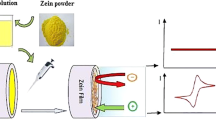Abstract
The objective of this work was to study, by impedance spectroscopy, polymer membranes modified by adsorption of anthraquinone-type redox mediators and conductive polymers. For that, asymmetric cellulose membranes were modified by adsorption of a textile dye (acid blue 129 or AQN-129) and a conductive polymer (poly(anilinesulfonic acid) or PASA). Membrane modification was performed by adsorption of AQN-129/PASA system from aqueous solution at different levels of ionic strength (low, half, and high). Later, interaction with divalent metal ions was analyzed by diafiltration experiments and electrochemical impedance spectroscopy using the single-sine technique. Results suggest that AQN-129 adsorption was enhanced with the increase of ionic strength (7.7, 13.8, and 16.2 % for low, half, and high ionic strength, respectively), average permeability coefficients for modified membranes decreased from 7.5 × 10−10 to 2.3 × 10−10 m3/m2sPa. In addition, for modified membranes, divalent metal ion retention increased in the following order Pb2+ > Cu2+ > Zn2 > Cd2+ > Co2+ > Ni2+. It is concluded that asymmetric cellulose membrane can change strongly their dielectric response by adsorption of conductive polymer. It was observed that changes in dielectric response can be modulated by adsorption of small amounts of AQN-129. Finally, results suggest that novel membranes could be developed by an adequate control of AQN-129 and PASA adsorption for different applications based on their dielectric response.







Similar content being viewed by others
References
Sirkar K (2008) Membranes, phase interfaces, and separations: novel technique and membrane: an overview. Ind Eng Chem Res 47:5250–5266
Li M, Zhao Z, Wang M, Zhang Y (2015) Controllable modification of polymer membranes by LDDLT plasma flow: antibacterial layer onto PE hollow fiber membrane module. Chem Eng J 265:16–26
Zhao C, Xue J, Ran F, Sun S (2013) Modification of polyethersulfone membranes—a review of methods. Prog Mater Sci 58:76–150
Palencia M, Vera M, Rivas B (2014) Modification of ultrafiltration membranes via interpenetrating polymer networks for removal of boron from aqueous solution. J Membr Sci 466:192–199
Ulbricht M (2006) Advanced functional polymer membranes. Polymer 47:2217–2262
Van der Zee FP, Villaverde S (2005) Combined anaerobic-aerobic treatment of azo dyes—a short review of bioreactor studies. Water Res 39:1425–1440
Keharia H, Madamwar D (2003) Bioremediation concepts for treatment of dye containing wastewater: a review. Indian J Exp Biol 41:1068–1075
Lee Y, Bottomley L (2011) Anthraquinone compounds as redox mediators for enhanced continuous-flow anaerobic biotransformation of reactive dyes under hypersaline conditions. Desalin Water Treat 33:68–76
Rau J, Knackmuss H, Stoz A (2002) Effects of different quinoid redox mediators on the anaerobic reduction of azo dyes by bacteria. Environ Sci Technol 36:1497–1502
Zhang H, Lu H, Wang J, Liu G, Xu M (2013) Global transcriptome analysis of Escherichia coli exposed to immobilized anthraquinone-2-sulfonate and azo dye under anaerobic conditions. Appl Microbiol Biotechnol 97:6895–6905
Lu H, Zhou J, Wang J, Teng H, Liu G (2010) Enhanced biodecolorization of azo dyes by anthraquinone-2-sulfonate immobilized covalently in polyurethane foam. Bioresour Technol 101:7196–7199
Guo J, Zhou J, Wang D, Tian C, Wang P, Salah M, Yu H (2007) Biocalalyst effects of immobilized anthraquinone on the anaerobic reduction of azo dyes by the salt-tolerant bacteria. Water Res 41:426–432
Cervantes FJ, Van der Zee FP, Lettinga G, Field JA (2001) Enhanced decolourisation of acid orange 7 in a continuous UASB reactor with quinones as redox mediators. Water Sci Technol 44:123–128
Nath Singh S (2012) Microbial degradation of xenobiotics. Springer, Berlin 500p
Van der Zee FP, Bouwman RH, Strik DP, Lettinga G, Field JA (2001) Application of redox mediators to accelerate the transformation of reactive azo dyes in anaerobic bioreactors. Biotechnol Bioeng 75:691–701
Saio D, Amaya T, Hirao T (2010) Redox-active catalyst based on poly(anilinesulfonic acid)-supported gold nanoparticles for aerobic alcohol oxidation in water. 352, 2177-2182.
Palencia M, Rivas B, Pereira E, Hernández A, Prádanos A (2009) Study of polymer–metal ion–membrane interactions in liquid-phase polymer-based retention (LPR) by continuous diafiltration. J Membr Sci 336:128–139
Palencia M, Rivas BL, Pereira E (2009) Metal ion recovery by polymer-enhanced ultrafiltration using poly(vinyl sulfonic acid): fouling description and membrane-metal ion interaction. J Membr Sci 345:191–200
Palencia M, Rivas B, Pereira E, Arrieta A (2010) Polyelectrolyte adsorption study on polyethersulfone membrane during polymer-enhanced ultrafiltration by electrochemical impedance spectroscopy. Polym Bull 65:145–156
Fathi MR, Asfaram A, Hadipour A, Roosta M (2014) Kinetics and thermodynamic studies for removal of acid blue 129 from aqueous solution by almond shell. J Environ Health Sci Eng 12:62. doi:10.1186/2052-336X-12-62
Acknowledgments
The authors wish to thank the University of Valle for financial support.
Author information
Authors and Affiliations
Corresponding author
Rights and permissions
About this article
Cite this article
Palencia, M., Arrieta, Á.A. & Melendrez, M. Study by impedance spectroscopy of polymeric membranes modified by adsorption of anthraquinone-type redox mediators and conductive polymers. Colloid Polym Sci 293, 3025–3032 (2015). https://doi.org/10.1007/s00396-015-3705-6
Received:
Accepted:
Published:
Issue Date:
DOI: https://doi.org/10.1007/s00396-015-3705-6




